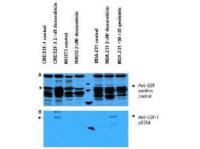
WB using E2F-1 pS364 ab shows detection of a ~47 kDa band corresponding to phosphorylated E2F-1 in induced cell lysates. Panel A shows reactivity using a control ab reactive to all forms of E2F (arrowheads). Panel B shows specific reactivity against phosphorylated E2F-1 (arrowheads) using anti-E2F-1 pS364. Lysates are as follows: CRE/E2F-1 are CRE cells derived from mouse NIH3T3 line transfected with human E2F-1, NIH-3T3 used as a negative control, and MDA-MB-231 cells are a human breast cancer line. Lysate was prepared from untreated cells or cells treated with 2 uM Doxorubicin used as DNA damaging agent. MDA-MB-231 cells were also treated with genistein, a mild DNA damaging agent. The figure shows the same membrane first probed with the anti-E2F-1 pS364 at 1:250, then stripped and re-probed with the pan E2F ab used as a positive control. The positive control ab shows an E2F-1 band in all human cell lines, but not mouse cells. Treatment with doxorubicin increases the expression of E2F-1 as shown in Panel A. After film development, images were overlapped to confirm that specific anti-E2F-1 pS364 staining shown treated human cells in Panel B specifically aligns with E2F-1 staining shown in Panel A.
E2F1 Rabbit Polyclonal Antibody

TA319248
ApplicationsWestern Blot, ImmunoHistoChemistry
Product group Antibodies
ReactivityHuman, Primate
TargetE2F1
Overview
- SupplierOriGene
- Product NameE2F1 Rabbit Polyclonal Antibody
- Delivery Days Customer14
- ApplicationsWestern Blot, ImmunoHistoChemistry
- CertificationResearch Use Only
- ClonalityPolyclonal
- Gene ID1869
- Target nameE2F1
- Target descriptionE2F transcription factor 1
- Target synonymsE2F-1; PBR3; PRB-binding protein E2F-1; RBAP1; RBAP-1; RBBP3; RBBP-3; RBP3; retinoblastoma-associated protein 1; retinoblastoma-binding protein 3; transcription factor E2F1
- HostRabbit
- IsotypeIgG
- Protein IDQ01094
- Protein NameTranscription factor E2F1
- Scientific DescriptionRabbit polyclonal E2F-1 phospho S364 antibody
- ReactivityHuman, Primate
- Storage Instruction-20°C
- UNSPSC12352203
